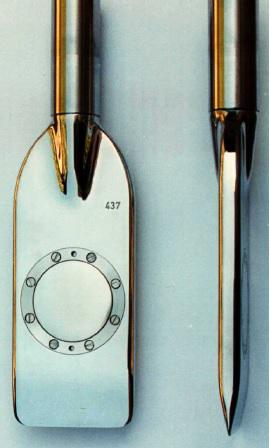Flat Dilatometer Test (DMT)
DMT determines in a quick, precise, simple and economical way various important parameters used in geotechnical design. The results are highly repeatable and independent of the operator. The DMT is used in 50 countries. It is standardized in the ASTM (USA) norms, in the Eurocode and CEN ISO/TS 22476-11:2005.
The field of application of the Flat Dilatometer Test DMT is very wide:
- Accurate settlement prediction of shallow foundations
- Compaction control
- Sensing the effects of pile installations
- Liquefiability of sands
- To verify if a slope contains slip surfaces
- Axially loaded piles in cohesive soils
- Laterally loaded piles
- Pavement subgrade compaction control
- Coefficient of consolidation and permeability of clays
- Phreatic level in sands
- Help in selecting FEM input parameters
In brief, the Flat Dilatometer consists of a stainless steel blade with a thin flat circular expandable steel membrane on one side. The blade is jacked into the ground and at 20 cm depth intervals the jacking is stopped and the membrane is inflated by means of pressurized gas. At each 20cm interval two readings are taken:-
The A-pressure, required to just begin to move the membrane against the soil (“lift-off”)
The B-pressure, required to move the centre of the membrane 1.1mm against the soil.
A third reading C (“closing pressure”) can also optionally be taken by slowly deflating the membrane soon after B is reached. The pressure readings A, B must then be corrected by the values ΔA, ΔB determined by calibration to take into account the membrane stiffness. These corrected pressures are denoted p0 and p1.
The blade acts as an electric switch (on/off) and pressures A, B and C are indicated by the presence/absence of an audible signal from the control unit as the membrane inflates and deflates again.
Raw field data can be either recorded manually, by reading the relevant pressures off gauges on the control unit, or recorded automatically by connecting the control unit to a laptop equipped with the DMT software package. The software inputs and processes the raw field data and derives all the common soil parameters, which may be printed out as Excel files or in graphical format.
The software also directly calculates the settlement prediction using the DMT data.




The table below shows derivations of the common soil parameters from the corrected DMT pressures p0 and p1.

The DMT is suitable for applications ranging from extremely soft soils to hard soils/soft rocks. This includes sands, silts and clays where the grains are small compared to the membrane diameter (60 mm). It is not suitable for gravels. However, the blade is robust enough to cross gravel layers of about 0.5 m thickness.
The dilatometer blade may be advanced into the ground by pushing with a cone penetrometer or with a drill rig. The DMT can also be driven, e.g. using the SPT hammer or sliding hammer, but statical push is the preferred method. Pushing the blade with a 20 ton penetrometer truck is the most effective method and yields the highest productivity (up to 80 m of soundings per day). Very light drill rigs, due to limited pushing capacity circa 2 tons, may be restricted to use in very soft soils or to very short depths. However, they are sometimes necessary in soils containing occasional boulders of hard layers, in order to drill past these obstacles. When DMT soundings are carried out after pre-boring, the initial test results obtained in the zone of disturbance at hole bottom (3-5 borehole diameters) must be treated with caution.
Methods of inserting the DMT blade are shown in the diagram below:-

While in principle, many kinds of rod can be used to push or drive the DMT blade, most commonly CPT rods or rotary drill rods are used. The rods must be hollow to allow the electrical-pneumatic cable to pass through the middle. An adaptor is needed to the blade at the lower end, and a special slotted adaptor at the top end to allow the cable to exit the drill string.Further information on the DMT can be downloaded by clicking on the link: The Flat Dilatometer Test in Soil Investigations

